Resilience
$79.95 $69.95
Resilience by ATP Science helps to provide an integral function by providing an adaptogenic formula that allows for balance by lifting up the immune system or bringing it back down to balance once again in whichever direction may be required and building our defence for whatever comes next!
Resilience by definition is the ability to learn, adapt and implement change; to bounce back and go again with a knowledge and understanding of how to best avoid that same outcome again. This is how our immune system is designed to be; however just like a seesaw, sometimes one side can become stuck down and you can end up with an underactive or overactive immune system that causes chaos, inflammation, flushing and a compromised feeling of being. The human body is an extremely intelligent machine that our innate immune system helps to keep in check – it responds to the threat and signals the all clear once the mission is complete. Resilience by ATP Science helps to support this integral function by providing an adaptogenic formula that allows for balance by lifting up the immune system or bringing it back down to balance once again in whichever direction may be required and building our defence for whatever comes next!
Resilience
“The strongest oak of the forest is not the one that is protected from the storm and hidden from the sun. It’s the one that stands in the open where it is compelled to struggle for its existence against the winds and rains and the scorching sun”
Napoleon Hill
Resilience: an ability to recover from, or adjust easily to misfortune or change
Survival
Have you ever put your hand on something hot and removed it before you felt the heat?
Have you ever felt something tickle your nose and then you immediately sneeze?
Have you ever had a sneezing fit and then asked yourself, “what was that? Dust? Pollen? Feather? Fragrance?”
We can’t afford to wait to assess a stress before we react. What if that tap on your leg was a venomous snake bite or a shark bite leaving a big bleeding hole. Or what if it was an opposing footballer trying to tackle you in a game? Your body must react as if it is life threatening, just in case.
(this may explain why Neymar dives and cradles his legs…poor bugger must think a shark rose up from the pitch and attacked him on the soccer field!)
SURVIVAL VERSUS OPTIMAL PERFORMANCE
So, now that we are convinced that survival is important, what do we do? Stimulate survival pathways and live forever! Stimulate and promote your immune activity and aggression.
When you stimulate your nervous survival techniques and you become an anxious, panicked insomniac that is thinking so much you have no idea what you were about to do. Your eyes are working hard for data and exert so much effort you can’t even read the paper in front of you. You become a tired but wired idiot.
If we stimulate and maximize our immune and inflammatory reactions, or prime it to be working overtime in anticipation, we will have a terrible quality of life and possibly reduced lifespan.
It is actually your immune system that makes you feel lousy when you have a cold or the flu, not the infecting bug. It is your immune response that determines how sick you feel. The pain associated with a sprain or bad back is your response to the trauma, you make the inflammation. Overstimulating survival mechanisms will create exaggerated responses, excessive mucous, fever, pain, aches, oxidative stress, and reactions. All aspects of aging have an inflammatory component.
For optimal performance, we want to be resilient. We want to be able to adjust, respond and recover quickly. Be tougher. Launch an efficient and effective defense and then switch off as soon as possible to protect the host (you) from your own defense mechanisms.
Refer to figure 3. To see that when our immune system is balanced and not stimulated we have no stress coming from our first line of defense. In this instance, we are ready to launch our defense efficiently but we are capable of staying in healing and recovery mode as a default when not actively fighting something or over stimulated and hyper-reactive.
Figure 3 – low dose exposure to small and big things
Maybe a lot of us are already stuck in overactive survival responses. Those that are over-reactive and/or stuck can manifest as the following disorders that are increasing at an alarming rate:
anxiety/panic disorders and depression
insomnia and poor sleep patterns
auto-immunity
allergy
fibromyalgia/chronic fatigue syndrome (and other pain and fatigue syndromes)
INNATE AND ACQUIRED DEFENSE
This is our “innate defense” mechanism. Stuff we have inherited from our parents via genetics and perinatal events. Once you launch a survival stress response and you survive; your body remembers and adds that to your repertoire of awesomeness so you may stay alive. The next time you get a stress trigger your body will bring out that new trick it has added to your innate defense mechanisms. These are our “acquired defense” mechanisms.
SHORT TERM (ACUTE) SURVIVAL
As we mentioned our defense mechanisms are designed for survival. Our Acute response to a challenge recruits all systems of the body to either get ready for action or shut down to send all resources to our survival plan.
Muscles burn what they have and don’t take any extra fuel from the bloodstream. They become insulin resistant to keep the sugar in the blood high to fuel the nerves, brain and immune system.
Oxidative blasts of free radicals, inflammation and chemical messengers called cytokines flood into bloodstream, liver and all mucosal and skin surfaces to flush, kill and purge any potential microbial threat or poison.
The liver speeds up its ability to convert toxins, poisons, and venoms into a water-soluble form to purge out through sweating, vomiting, and diarrhea and forgets about its other maintenance jobs. It also releases more sugar into the bloodstream and just in case of injury it makes your blood gluggy and sticky to be easier to clot in case of a bleeding injury.
The nervous system changes priorities away from resting, digesting, repairing and reproducing and focuses on gut instincts, intuition, far vision, anxiety, and panic.
Sexual desire is shut down for long enough to survive at least and reproduction is not an option while needing to fight or run.
Refer to Figure 1. When you are exposed to potential infections; you launch an immediate innate defense at the site of invasion at the mucosa, which is our first line of defense and the most likely place for infection. Simultaneously you initiate a systemic survival response that changes your priorities to survive today and forget the rest.
Figure 1: High dose exposure to small things
When exposed to big things like allergens or parasites your body’s innate defense mechanisms are the same; they attack the mucosa and launch a systemic defense strategy. Your body does not wait to see if it is an infection or an allergy, dead or alive.
We shoot first and ask questions later.
After a reasonable period of time, usually only seconds to minutes your body recognizes that you have launched an acute stress response and it will attempt to shut it down in an attempt to protect you from your own defense mechanisms. You can’t live that way…well not for very long and not very well anyway.
If you get another stress trigger while you are still coming down from your previous problem then your body must go again. You will ignore your negative feedback and go again. If this keeps happening due to your stress response going so high in the first place and still trying to come down as in post-traumatic stress disorder (PTSD) or if you experience constant ongoing repetitive daily or hourly stress long-term then you can move into a phase of chronic stress.
LONG-TERM (CHRONIC) SURVIVAL
If the stress response is extreme and/or persistent you can get stuck in a survival mode and your body struggles to control your defense mechanisms. Your own innate and acquired survival skills start to damage your body.
Chronic long-term immune activation, inflammation, and oxidative stress start to attack and destroy your body. Disease occurs through over-reactive immune responses (autoimmunity) where your own immune system gets confused and starts attacking your own body as if it was an invading organism or allergic disorders that leave you in a constant flushing reaction with swelling, itching, mucous and sneezing.
All aspects of aging are associated with inflammation and the hormones necessary to control that inflammation are either switched off, resistant or exhausted.
The mucosal membranes that make up your first line of defense as a physical barrier and that house your commensal friendly gut flora that create your bio-barrier are stripped and eroded and damaged to the point of becoming leaky and allowing more inflammatory, microbial and allergenic challenges into your system to keep the vicious cycle going.
The nervous system is still focused on survival. If you aren’t fighting or running you should be hiding and still on edge ready to go. Digestion is compromised and your ability to break down foods and sterilize food to prevent more pathogenic organisms with stomach acid is defective so more and more immune challenges and burden to the liver is delivered with each meal.
The liver is still focused on its role in survival; keeping high blood sugar, sticky blood ready to clot and not bothering cleaning up the mess with hormones, endocrine disrupting chemicals, plastics and not capable of keeping up with its maintenance jobs as it processes all of the by-products of your innate defense mechanisms. The toxins that are stuck between phase 1 survival reactions and phase 2 clean up and elimination detoxification pathways are highly reactive and further aggravate inflammatory and oxidative stress reactions all over your body.
DOOMSDAY PREPPING
Survival techniques revolve around learning from the past to prepare for the future. But how do we prepare for new technology and prepare for our new world?
Doomsday does not necessarily have to be a sudden change, post-nuclear weapons or armageddon. It may simply be a tipping point in electromagnetic radiation, pollution, mutated bugs or even allergies. We need to have an educated guess and create some safeguards to help our resilience to modern threats.
The future may be different to your inherited and acquired defense strategies from the past, how do we plan for the worst? Some of the more likely challenges to add to our normal burden in the future are likely to be:
Increased exposure to electromagnetic radiation and Wi-Fi
Increased exposure to plastics, fumes and other pollutants
Mutated bugs and infections
Microbiome disruption from excessive glyphosate (round-up) or others, antibiotics and prebiotics with insufficient ModbioticsTM
Allergies
So, what is the key to survival?
Only the strong will survive? Launching too strong a survival mechanism is not what we want.
Brain over braun? Your acquired intelligence can lead to more problems. When it comes to your immune system it is harder to unlearn than learn. Once it has a memory for something it can be your worst enemy.
The goal is RESILIENCE.
How do we become more Resilient?
The key to resilience is to not allow things to affect you so much. Toughen up, “get a thicker skin” so to speak. Reduce the burden from things that are in your control and stop over-reacting to unexpected challenges. Of course, that is it. Intuitively we know it. We are our own worst enemies, right?
No, it is not all in our minds. We are bombarded by so many stresses all of the time and you have no idea what it is. How could you possibly know as a mum, accountant, sportsman, doctor, naturopath how could any of us really know how much stress reactions are occurring in response to Wi-Fi, noise, a chemical we use or a smell, or an imbalance in our microbiome where our good bugs have overgrown and become bad or a deficient and there is a Klebsiella or candida colony thriving or a parasite plodding along.
We blame the things, habits, people, food or chemicals we see in front of us or read on a label. We blame ourselves and our lack of sacrifice or dedication or intensity.
Give yourself a break. The world around us and inside of us is changing so fast there is no way we can evolve fast enough to keep up with the rate at which our external and internal environment is evolving.
NATURE ALWAYS KNOWS BEST
Nature has always provided us with everything we needed to create and sustain life and there are some amazing tools we can use to fortify our diets to fortify our first line of defense.
ModbioticTM compounds
Our food has changed significantly for various reasons, including; poor farming practices, harvesting and storage techniques, genetic engineering, use of glyphosate and other pesticides and our personal preferences and purchases.
This has resulted in more sugar and less fiber, thinner skins, and peels, fewer or no seeds, less pulp and rind and all of the parts of the plant that contain modbiotic plant compounds. Modbiotics are natural poisons that control microbial balance in our external and internal environments.
ATP science GUTRIGHT ™ is a blend of modbiotics compounds supplemented into the diet to regulate intestinal microbiome and regulate digestion, intestinal detoxification, gut-derived inflammation and bowel function.
Essential nutrients
Our food is also deficient and, in many cases, devoid of micronutrients. Even when purchasing organic and biodynamic you do not know if the vitamin and mineral level is adequate. You know it doesn’t have the bad stuff on the outside but how do you know if it has all the good stuff inside of it.
Structuring our diet with the right level of macronutrients (protein, carbohydrate, and fat) and fortifying your diet with the essential vitamins, minerals and essential fatty acids has become necessary.
Nature has provided synergistic co-factors to work with the essential nutrients which is why plant-based nutrition, using old-school farming techniques with modern testing abilities to standardize the plant material to guarantee delivery of the required nutrients is the best way.
An example of cofactors at work is if you look at the way your body can utilize essential fatty acids if you have all of the cofactors. Fish oil contains a special oil abbreviated to EPA, that is the fish oil claim to fame. And we are often told that we must eat fish to get EPA for our brain as that is our only dietary source. However, if you supply the plant-based precursor from nuts and seeds along with vitamins B and C and the mineral magnesium that are all supposed to be naturally in our fruit and vegetables, nuts and seeds, our body can convert it all the way to EPA. New research on the power of herbs and spices has shown that people who consumed a consistent dose of turmeric actually gained a higher level of EPA that a comparison group taking EPA supplements.
ATP Science Multifood™ contains plant-based vitamins and minerals grown using old school farming practices but processed, stored, tested and standardized every batch for consistency and reliability.
ATP science Resilience™ is a powerful blend of shielding and fortifying herbs and spices: Turmeric, Reishi, Frankincense, Myrrh, Artemisia, and Amla.
ATP Science Pillar 04 – is coming soon
Shielding and fortifying herbs and spices
Nature in its wisdom has also supplied powerful herbs and spices for us to add to our diets to help protect us from unnecessary burden from pathogenic microbes, toxic exposure, and electromagnetic radiation.
They dampen down the severity of the damage from the initial exposure and protect our body from our own defense mechanisms that have been released excessively in response to an acute challenge or are stuck in chronic stages of long-term dysregulation.
Fortifying our first line of defence requires
Barrier defence
Physical barrier
Skin
Mucosa
Biological barrier
microbiome
NRF2 gene activation
Anti-Inflammatory support
Anti-oxidant support
Detoxification
BARRIER DEFENCE
The body has several mechanical, chemical, and biologic barriers that provide the first line of defense. These barriers can be thought of as the moats and thick walls that provided the initial protection to the inhabitants of castles under enemy attack.
Physical Barriers
The initial mechanical barriers that protect the body against invasive microbes include the skin epidermis and keratinocytes; the epithelium that makes up the mucous membranes of the gastrointestinal, respiratory, and urogenital tracts; and the cilia in the respiratory tract. These mechanical barriers also incorporate biologic barriers that maintain the physical wall and help to minimize or prevent entry into the body.
Skin
The epidermis or outer layer of the skin varies in thickness from 0.05 to 1.5 mm depending on location (Fig. 3.2). The outermost of the five layers is composed of dead, tightly layered, and cornified squamous skin cells. Providing a watertight barrier that prevents dehydration and provides a microbe-inhospitable dry environment on the surface of our skin. Your body constantly makes new skin cells so the old ones constantly shed; sloughing of the superficial epidermal layer removes microbes attached to cutaneous surfaces.
Mucous membranes
The mucous membranes line all of the body’s internal cavities that come into contact with the environment, such as the oral, nasal, respiratory, gastrointestinal, and urogenital tracts. This epithelium contains immune cells called goblet cells that secrete mucus. Approximately 4 L of mucus is secreted by the mucosa of the gastrointestinal tract alone every day and then most of it is resorbed in the large intestine to form a solid stool. In the respiratory tract, the mucus traps and flushes away inhaled bacteria, fungi, and other particles. In the gastrointestinal tract, the mucus and mucous membranes help to protect the gut lining and underlying tissues from damage by digestive enzymes and to carry the ingested matter through the digestive tract. Additionally, the sloughing of the intestinal epithelial cells has a protective effect similar to that of the sloughing of skin cells.
Your mucosal surfaces must police the exchange of good and bad molecules between you and your environment with the environment while also resisting microbial invasion and toxic exposure.
Respiratory tract
Air turbulence created by your nose hairs within the nostrils keeps particles larger than 10mm in the nasal mucosa. The hair-like cilia lining the respiratory tract passages help keep the tract clean by moving the mucous containing trapped microbes and particles outward for expulsion by coughing and sneezing.
Genito-Urinary tract
The flushing effect of urination helps to inhibit the movement of microbes from the environment up into the bladder and kidneys.
The female Genito-Urinary tract is also protected by the acidic secretions in the vagina and the presence of microcidal molecules secreted by the mucous membranes.
CHEMICAL AND ENVIRONMENTAL BARRIERS
The acidic pH of the skin, stomach, and vagina serves as a chemical barrier against microbes. Microcidal molecules such as α-defensins, β-defensins, cathelicidin, RNases, DNases, and lysozyme, are secreted by various barrier cells to provide protective environment barriers.
pH
Most pathogens are very sensitive to an acidic environment where an acid pH inhibits the growth of potential pathogens.
Microcidal action of secreted molecules
Several tissues that are in contact with the environment synthesize and secrete various microcidal molecules that act to inhibit or kill microbes that are attempting to colonize.
BIOLOGIC BARRIERS: COMMENSAL MICROBES
Commensal microbes are those that live within us; on our skin and coating our internal membranes and co-existing in a symbiotic relationship with our body (their host).
The skin and the gastrointestinal tract are colonized by more than 500 commensal bacterial and other microbial species that are estimated to make up more than 95% of the cells present in a normal human body. There are 10x as many microbes living on and inside us than there are whole human cells of our bodies.
Commensal microbes colonizing the skin and gastrointestinal tracts “defend” their territory and inhibit the establishment of other potentially pathogenic microbes. These microbes also assist in our digestive, metabolic, detoxification, maintenance and acute and chronic survival processes.[1]
ATP Science RESILIENCE
Each capsule contains equivalent to fresh plant;
Reishi (Ganoderma lucidium) mushroom 15,000mg
Amla (Phyllanthus emblica) fruit 25,000mg yielding 50mg ascorbate and 50mg bioflavonoids
Turmeric (Curcuma longa) root 12,500mg
Frankincense (Boswelia serrata) oleoresin 2,250mg
Myrrh (Commiphora myrrh) 3,750mg
Chinese wormwood (Artemisia annua) leaf 5,000mg
Herbs and spices for membrane integrity
It is essential to make sure that you have adequate levels of essential nutrients to make sure you are capable of building and maintaining an effective physical barrier. Vitamins, minerals, amino acids and nutrients supplied by your diet or made from our friendly microbes in our Bio barrier are delivered to this first line of defense for regeneration and repair. Keep in mind that this will occur while in rest, digest and recovery mode only.
During an acute or chronic stress while in survival mode we are busy shedding and flushing this membrane and depleting it of nutrients needed for survival. This creates damaged, inflamed, raw and permeable membrane.
Physical barrier
Frankincense, myrrh, and turmeric are extremely valuable and powerful tools for maintaining our first line of defense. They are very powerful natural anti-inflammatories but unlike most pharmaceutical drugs or a lot of other natural aspirin-like anti-inflammatory compounds they are also anti-inflammatory and soothing to the mucous membranes and prevent permeability and leaky gut wall. Maintaining a tough and resilient mucous membrane.
Other than inflammation, our membranes are also damaged by the infiltration of hyper-reactive immune cells. Cytokines are chemical messengers released immediately with stress and they attract immune cells to the area to instigate the inflammatory attack and launch indiscriminate chemical attacks with oxidative bursts of free radicals and other damaging compounds like histamine.
Frankincense, myrrh, turmeric, reishi, amla and artemisia work together to protect our physical barriers from being stripped by our own defense mechanisms.
Bio-Barrier
Our ratios between good and bad microbes living in our mucous on our mucosal membranes have many contributing factors; genetics, environmental exposure, hygiene, dietary macronutrient ratios and fiber (prebiotics), dietary polyphenols and poisons (modbiotics), pesticides on our foods and antimicrobial drugs in our foods (antibiotics).
Using specific tools in our diet to
Reduce the dose of exposure to pathogenic microbes through antimicrobial actions; basically, killing off the bad or blocking their entry through or adhesion to our membranes before our immune system has to deal with them. Reishi, amla, frankincense, myrrh, turmeric, and artemisia have potent antimicrobial actions active against multiple pathogenic virus, bacteria, fungi and parasites summarised below.
Support a healthy friendly microbiome that competes with pathogenic organisms, blocking their entry, growth, and reproduction. Turmeric and artemisia in particular work as modbiotic compounds to support our commensal microbiome. During stress and infection, they can be used in higher doses on top of our normal daily dose of modbiotic compounds to protect our gut flora from our own antimicrobial defense mechanisms.
Disrupt biofilm and mechanisms that pathogenic microbes or overgrown commensal microbes can become resistant to treatment. Colonies of bugs can become well established and create a protective shell that our poisons may not get through. Frankincense, turmeric, artemisia help disrupt the biofilm and allow the poisons and modbiotics in.
GUT WALL AND INTESTINAL PERMEABILITY
Frankincense is possibly the most effective anti-inflammatory agent that also protects, heals and soothes the intestinal mucosa reducing intestinal permeability, polyp formation[i] and damage. Many pharmaceutical and natural anti-inflammatories can damage the gut mucosal lining contribute to a leaky gut wall and thereby creating more inflammation. Frankincense combines well with myrrh and turmeric as one of the best natural anti-inflammatory combinations that can help to soothe and protect the mucosal lining as well as have a profound systemic anti-inflammatory action.
Reishi[ix] and Myrrh stabilizes mucosa, prevents intestinal inflammation to stop leaky gut wall.
Artemisia annua can help to modulate the microbiome while supporting the protection and healing of the mucosal lining
Turmeric regulates microbiome and aids intestinal mucosa integrity and this may be one of the main mechanisms behind turmeric’s health benefits as the active ingredients do not have efficient systemic bioavailability with up to 90% of the actives excreted in faeces.
ANTIMICROBIAL ACTIONS
The foods contained in resilience have a long history of use as antimicrobial agents.
Frankincense and myrrh burnt during gatherings and ceremonies for hygiene purposes, sterilizing the indoor air and preventing the spread of infections.
ANTIBACTERIAL
Amla may help reduce bacterial infections; Staphylococcus aureus, Staphylococcus saprophyticus, Escherichia coli, Enterococcus faecalis, Enterococcus cloacae, Proteus vulgaris and Klebsiella pneumoniae[xxii] and Strep infections, reducing throat infections, firmicute dominance and prevent dental caries. [xxiii]
Frankincense has potent antimicrobial actions, in particular it helps to kill resistant and recurrent staph aureus that has been resistant to treatment directly and it also damages its protective biofilm
Artemisia is a broad spectrum anti-bacterial compound
Turmeric reduces the overgrowth of pathogenic and commensal firmicutes such as e. coli, Staph aureus, and salmonella.[xxix]
ANTIVIRAL
Amla may help to stop HSV herpes and HPV warts virus flare-ups and infection by inhibiting attachment, penetration, infection, and replication. Amla may also be effective against Coxsackie B virus and protects against the damage from viral infection.
Frankincense has antiviral actions against some mosquito-borne viruses that is promising. They have also been shown to be active against EBV glandular fever.
Turmeric may help those with HPV wart virus, hepatitis B and C infection, zika virus and other mosquito-borne viruses[xxxix]
Reishi has an antiviral effect. They have been shown to help prevent glandular fever as they are active against Epstein Barr virus (EBV) infection. [xl] Promising signs against HPV being investigated further Oral human papillomavirus (HPV). Enterovirus 71 (EV71) is a major causative agent for hand, foot, and mouth disease (HFMD) that does not have an effective drug treatment, Reishi is being investigated as a possible treatment with good success. Hepatitis B replication may be inhibited by reishi and the anti-inflammatory actions from reishi help protect the liver from inflammation from hepatitis virus as well as the gut-derived inflammation from a leaky and inflamed gut. [xliv]
Artemisia annua has antiviral actions against HSV and hepatitis B and C
CANDIDA
Reishi inhibits new and disrupts existing candida biofilm, thereby allowing anti-candida actives to be more effective. [xlvi] Reishi contains compounds that are active against multiple forms of candida directly.
Amla inhibits candida adhesion to the mucosa.
Frankincense helps breakdown candida biofilm
Artemisia has anti-fungal properties directly and also disrupts biofilm.
Turmeric can help prevent resistance to anti-fungal drugs and amplifies the effects of other anti-fungal compounds.
ANTI-PARASITIC
Artemisia annua has been traditionally used and studied mainly for its anti-parasitic actions as its main claim to fame is as an anti-malaria drug. Artemisia appears to be active against multiple parasites. [lvi]
The studies on Reishi against Malaria are very promising, but possibly the most exciting aspect of the study was the protective effect on the liver and improvement in liver damage in the group treated with Reishi.[lvii]
Turmeric has interesting constituents being studied for anti-parasitic properties preventing adhesions, growth, and survival of parasites.[lviii][lix][lx]
Immune modulation
A balanced immune system does not add stress, inflammation, oxidative stress and toxic burden to your body like an imbalanced immune system does. Immune over-activity, over-reactivity or overwhelmed due to insufficiency creates immune symptoms (infection feeling, autoimmunity, allergy), stress and keeps you stuck in survival mode.
Balance the immune system to allow for an effective and efficient defense when primed and then switch off acute response and go back to immune surveillance and maintenance.
Myrrh modulates the chemical messengers called cytokines to stimulate the immune system when needed to fight infection and then back off in cases of overactive immune responses in autoimmunity.
Frankincense helps to modulate the innate immune response; dampens inflammation and oxidative stress regardless of which aspect of the immune system initiated the attack; allergic hypersensitive conditions like asthma and dermatitis, autoimmunity, mucosal integrity and oral tolerance. Frankincense helps to regulate inflammation and antioxidant systems but also may help target immune dysfunction targeting the cause of the inflammation and oxidative stress.
Artemisia is famous for anti-parasitic actions and as an anti-malaria drug. It was often assumed that is a potent poison to everything including invading organisms but also against our friendly gut flora like a potent antimicrobial drug or chemotherapeutic. However, it also has immune-modulating properties showing benefit in suppressed immunity leading to infection or overactive immunity in autoimmunity; overactive flushing reactions seen in allergy and then can stimulate that pathway when deficient to eradicate parasites. At the same time, it is having a beneficial effect in controlling the severity of inflammation and the damage from this inflammation. [lxviii] [lxix][lxx][lxxi]
Turmeric can help dampen down the innate inflammatory and immune responses that predispose to being stuck in stress and survival mode, autoimmunity and overactive immune responses
NRF2 activators
Our NRF2 gene is our resilient gene. When activated, NRF2 genes initiate a cascade of events to activate our protectant anti-inflammatory, anti-oxidant, detoxifying and anti-stress pathways to protect us from invading infections, abnormal cells, toxic exposure, poison, venom, pollution, radiation or protect our own tissues from our own defense mechanisms. Once things get past our barriers it is the NRF2 gene that we need to activate to survive.
NRF2 gene activation is being researched heavily as a doomsday prepping strategy for the unknown future. Our world is changing so fast we need to work with what we have as we can’t rely on evolution changing us fast enough.
The following are well studied and extremely potent NRF2 activators:
Turmeric
Myrrh
Frankincense
Reishi
Artemisia annua
Amla herb directly is a powerful NRF2 activator [xcvii] that also yields a strong dose of vitamin C and bioflavonoids including rutin and quercetin[c] as essential nutritional cofactors in the NRF2 antioxidant[ci] and anti-inflammatory mechanisms protection pathways.
Inflammation and Pain relief
Inflammation and pain can form a vicious cycle that is damaging, stressful and exhausting. Other than NRF2 activation, these compounds also help reduce pain and inflammation through other mechanisms to remove the burden.
Frankincense, turmericand myrrh reduce inflammation and pain sensitivity.
Many pharmaceutical and natural anti-inflammatories can damage the gut mucosal lining contribute to a leaky gut wall and thereby creating more inflammation. Frankincense, myrrh, and turmeric can protect against this. [cxviii]
Myrrh has been shown to help with arthritis, headaches, ear and oral mucosal inflammation[cxix] and reduce pain sensitivity. Reishi is anti-inflammatory and pain reliever and as is Amla.
Liver protectants and detoxification support
Artemisia, Frankincense, Myrrh and Turmeric protect the liver from damage, reduce the “acute phase response”, “reboots” the phase 1 and phase 2 detoxification pathways that are initiated and often stuck as part of a survival strategy.
Amla has been shown to be superior to arguably the most famous “liver herb” silymarin and shown to be superior due to the inclusion of the nutritional cofactors of vitamin c and flavonoids as well as the hepatoprotective polyphenols. This may help to protect you from the toxicity of such things as cadmium exposure
Anti-stress
By removing stress triggers such as pain, inflammation, immune activation, toxic exposure improving your resilience is stress relieving.
However, with extreme acute and ongoing chronic stress, we can get stuck in survival mode and can struggle emotionally to cope. Turmeric not only improves your resilience but also reduces the severity of your stress response to stress triggers with anti-anxiety effects and as does Myrrh with antidepressant actions.
By managing the degree of stress response and allowing it to switch off and reset. Turmeric and Myrrh can help other hormonal systems to function efficiently. Turmeric supports adrenal, gonadal and thyroid hormones. Myrrh supports the thyroid axis to work efficiently
Nutritional Info
ATP Science Resilience Serving Size Servings Per Container Caps 90
Nutritional Info Per Serve Per 100g
Energy 10kJ
2.5Cal 1399kJ
334Cal
Protein 0.02g 2.5g
Fats Total –
Saturated 0.01g
0.0g 1.9g
0.15g
Carbohydrates –
Sugars 0.5g
0.01g 70g
1.5g
Dietary Fiber 0.02g 2.9g
Sodium 0.9mg 122mg
Vitamin C 50mg 6662mg
Non Citrus Bioflavanoids 10mg 1332mg
Other Ingredients
ATP Science Resilience blend: Ganoderma lucidium (Reishi) extract, Turmeric (Curcuma longa) root extract, Boswellia serrata (Indian Frankincense) resin, Orgentics, Orgen-C Amla (Phyllanthus embilca) extract, Artemisia annua (Chinese wormwood) leaf extract. Commiphor amyrrha (Myrrh) resin.
Resilience Directions
Take 1 capsule 3 times a day with food. Capsules can be opened and sprinkled onto food or added to juice or smoothies as desired.
Storage
Keep in cool dry place out of direct sunlight. Store below 30°C.
| Size |
|---|
Be the first to review “Resilience” Cancel reply
You must be logged in to post a review.
Related products
Body Building
Alternate Therapies
Anabolic Formulas
Energy Formulas Non Stimulant
Detox
Hayfever
Alternate Therapies
Cold + Flu

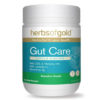
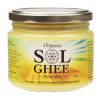
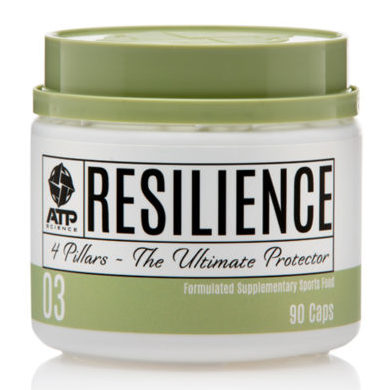
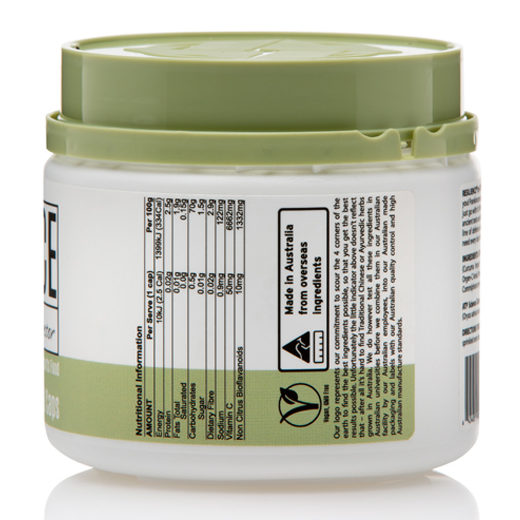
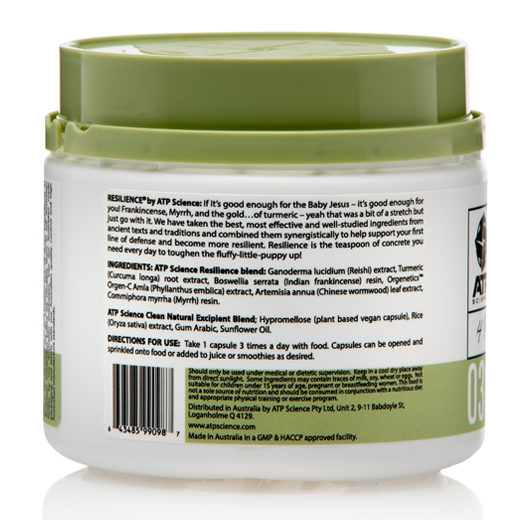
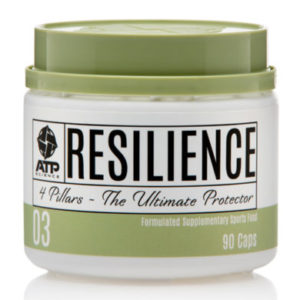
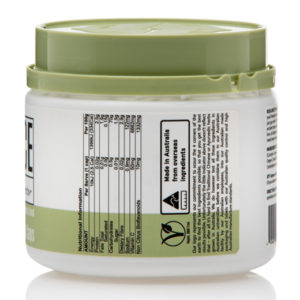
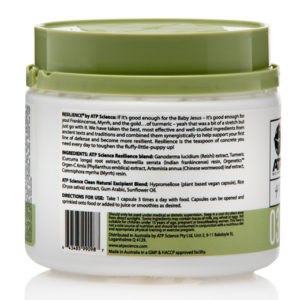
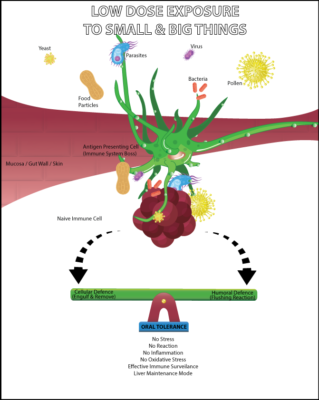
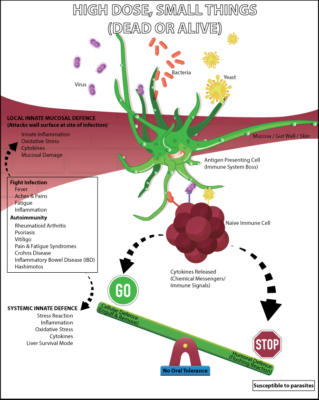
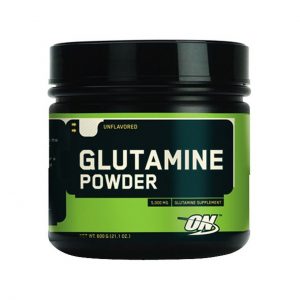
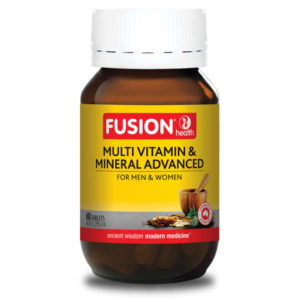

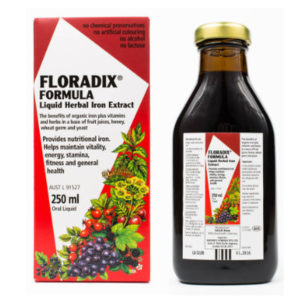
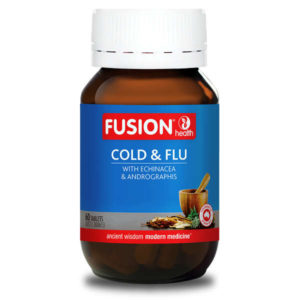
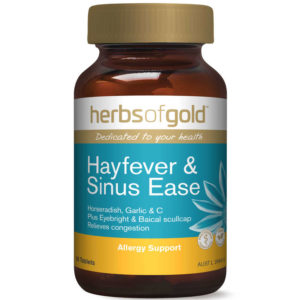
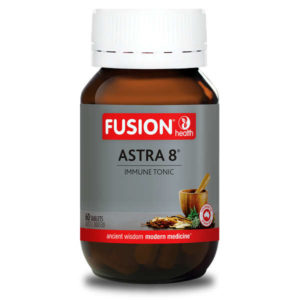
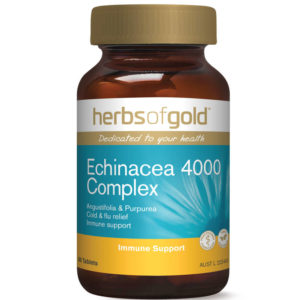
Reviews
There are no reviews yet.